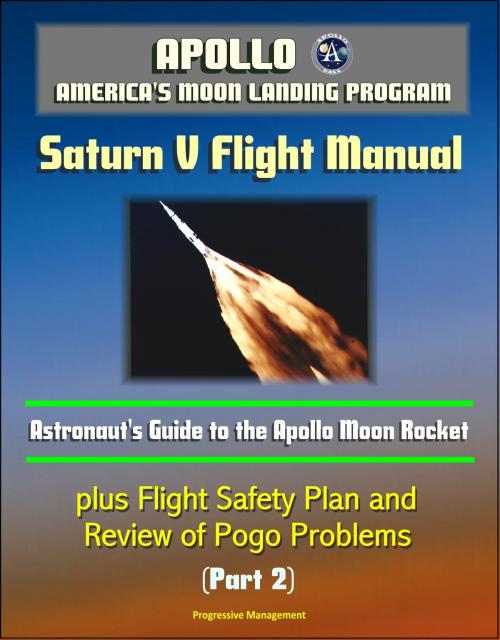Apollo and America's Moon Landing Program: Saturn V Flight Manual: Astronaut's Guide to the Apollo Moon Rocket, plus Flight Safety Plan and Review of Pogo Problems (Part 2)
Nonfiction, Science & Nature, Technology, Aeronautics & Astronautics, Science, Physics, Astrophysics & Space Science| Author: | Progressive Management | ISBN: | 9781310843372 |
| Publisher: | Progressive Management | Publication: | September 6, 2014 |
| Imprint: | Smashwords Edition | Language: | English |
| Author: | Progressive Management |
| ISBN: | 9781310843372 |
| Publisher: | Progressive Management |
| Publication: | September 6, 2014 |
| Imprint: | Smashwords Edition |
| Language: | English |
Learn about the Saturn V moon rocket with this unique collection of documents, anchored by the illustrated Saturn V Flight Manual, written for the astronauts flying the mammoth Apollo moon rocket. Containing over 210 illustrations, line drawings, and figures, this ebook reproduction has fascinating information about flight systems, events, and crew interactions. (The book is presented in two parts because of its large file size.) This edition was produced for the Apollo 8 first manned Saturn V mission and has a special level of extraordinary technical detail. As a bonus, two small documents provide additional information:
The Apollo/Saturn V Flight Safety Plan Vehicle AS-504, February 22, 1969, presents flight safety requirements, restrictions, and instrumentation necessary for launch. The plan defines flight safety responsibilities of the Air Force Eastern Test Range (AFETR) and Kennedy Space Center (KSC). The requirements for flight termination and propellant dispersion are described, and the restrictions and instrumentation applicable for the Apollo/Saturn V flight are listed.
A Marshall Space Flight Center presentation by the Lesson Learned Panel on Selected Saturn V History in 2010 reviews the pogo problems which crippled the second Saturn V launch (Apollo 6) and led to improvements and a pogo suppression system for the second stage by the time of the Apollo 14 launch.
Flight Manual contents include: In-Flight Contingencies and reactions * Extensive coverage of abort modes and timelines * An extremely thorough review of the S-IVB Auxiliary Propulsion System Control Module and its 150-lb and 70 lb. engines * Unique detailed descriptions of the flight program and instrumentation systems * Engine Start and Engine Cutoff * Stage Subsystems - tanks, propellant feed, electrical, battery, instrumentation, telemetry, and more * A comprehensive review of the booster changes implemented prior to Apollo 8 which eliminated the potentially deadly pogo phenomenon Launch Vehicle Description * Range Safety And Instrumentation * LV Monitoring And Control * Safety * Stage Separation * Umbilicals * Electrical Systems * Manufacture And Launch Concepts * Launch Requirements * Reliability And Quality Assurance * Analysis Of Mission Profiles * Failure Effects And Criticality Analyses * Design Reviews * Vehicle Development Flow * Certification And Review Schedules * Transportation * Launch Vehicle Description * General Arrangement * Interstage Data Flow * Range Safety And Instrumentation General * Ground Safety * Flight Safety * Emergency Detection System * Hazardous Gas Detection * Propulsion * Engine Operating Requirements * Purge, Prefill, And Thermal Conditioning * Pogo Suppression System * Engine Subsystems * Hypergol Manifold * Control Valve - 4-Way * Turbopump * Gas Generator * Heat Exchanger * Main Fuel Valve * Main LOX Valve * Checkout Valve * High Voltage Igniters * Engine Operation * Engine Cutoff * Emergency Engine Cutoff * Note * Flight Control System * Fluid Power * Hydraulic Servoactuator * Pneumatic Controls * Propellants * Fuel Loading And Delivery * RP1 Pressurization * RP1 Delivery * LOX Loading And Delivery * LOX Drain * LOX Pressurization System * LOX Delivery * Electrical * Distributors * Main Power Distributor * Sequence and Control Distributor * Propulsion Distributor * Thrust Ok Distributor * Timer Distributor * Measuring Power Distributor * Switch Selector * Instrumentation * Telemetry System * Measurement System * J-2 Rocket Engine * Start Preparations * Engine Start Sequence * Engine Cutoff * Cutoff Sequence * Malfunction Detection * Flight Control * Preflight Operation * Inflight Operation * Pneumatic Controls * Ground Pneumatics * Onboard Pneumatics * Stage Propellant Valve Control System * Propellants * Propellant Servicing System
Learn about the Saturn V moon rocket with this unique collection of documents, anchored by the illustrated Saturn V Flight Manual, written for the astronauts flying the mammoth Apollo moon rocket. Containing over 210 illustrations, line drawings, and figures, this ebook reproduction has fascinating information about flight systems, events, and crew interactions. (The book is presented in two parts because of its large file size.) This edition was produced for the Apollo 8 first manned Saturn V mission and has a special level of extraordinary technical detail. As a bonus, two small documents provide additional information:
The Apollo/Saturn V Flight Safety Plan Vehicle AS-504, February 22, 1969, presents flight safety requirements, restrictions, and instrumentation necessary for launch. The plan defines flight safety responsibilities of the Air Force Eastern Test Range (AFETR) and Kennedy Space Center (KSC). The requirements for flight termination and propellant dispersion are described, and the restrictions and instrumentation applicable for the Apollo/Saturn V flight are listed.
A Marshall Space Flight Center presentation by the Lesson Learned Panel on Selected Saturn V History in 2010 reviews the pogo problems which crippled the second Saturn V launch (Apollo 6) and led to improvements and a pogo suppression system for the second stage by the time of the Apollo 14 launch.
Flight Manual contents include: In-Flight Contingencies and reactions * Extensive coverage of abort modes and timelines * An extremely thorough review of the S-IVB Auxiliary Propulsion System Control Module and its 150-lb and 70 lb. engines * Unique detailed descriptions of the flight program and instrumentation systems * Engine Start and Engine Cutoff * Stage Subsystems - tanks, propellant feed, electrical, battery, instrumentation, telemetry, and more * A comprehensive review of the booster changes implemented prior to Apollo 8 which eliminated the potentially deadly pogo phenomenon Launch Vehicle Description * Range Safety And Instrumentation * LV Monitoring And Control * Safety * Stage Separation * Umbilicals * Electrical Systems * Manufacture And Launch Concepts * Launch Requirements * Reliability And Quality Assurance * Analysis Of Mission Profiles * Failure Effects And Criticality Analyses * Design Reviews * Vehicle Development Flow * Certification And Review Schedules * Transportation * Launch Vehicle Description * General Arrangement * Interstage Data Flow * Range Safety And Instrumentation General * Ground Safety * Flight Safety * Emergency Detection System * Hazardous Gas Detection * Propulsion * Engine Operating Requirements * Purge, Prefill, And Thermal Conditioning * Pogo Suppression System * Engine Subsystems * Hypergol Manifold * Control Valve - 4-Way * Turbopump * Gas Generator * Heat Exchanger * Main Fuel Valve * Main LOX Valve * Checkout Valve * High Voltage Igniters * Engine Operation * Engine Cutoff * Emergency Engine Cutoff * Note * Flight Control System * Fluid Power * Hydraulic Servoactuator * Pneumatic Controls * Propellants * Fuel Loading And Delivery * RP1 Pressurization * RP1 Delivery * LOX Loading And Delivery * LOX Drain * LOX Pressurization System * LOX Delivery * Electrical * Distributors * Main Power Distributor * Sequence and Control Distributor * Propulsion Distributor * Thrust Ok Distributor * Timer Distributor * Measuring Power Distributor * Switch Selector * Instrumentation * Telemetry System * Measurement System * J-2 Rocket Engine * Start Preparations * Engine Start Sequence * Engine Cutoff * Cutoff Sequence * Malfunction Detection * Flight Control * Preflight Operation * Inflight Operation * Pneumatic Controls * Ground Pneumatics * Onboard Pneumatics * Stage Propellant Valve Control System * Propellants * Propellant Servicing System















